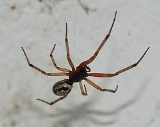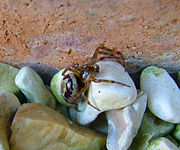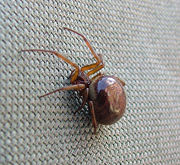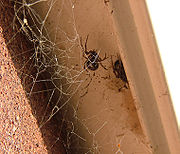
Steatoda nobilis
Encyclopedia
Steatoda nobilis, commonly known in England
as the biting spider or the false widow (though several other species are known by the latter name), is a common species of spider
in the genus Steatoda
. As one of this spider's common name indicates, the spider superficially resembles, and is frequently confused for, the black widow
and other venomous spiders in the genus Latrodectus. The spider is native to the Canary Islands
but arrived in England in around 1870 through bananas sent to Torquay
. In England it has a reputation as one of the few local spider species which is capable of inflicting a painful bite to humans - although this is a comparatively rare occurrence.
s, S. nobilis has a round, bulbous, over-sized abdomen, which is darkly colored. Females typically have pale marble like markings on the dorsal side of the abdomen, with a cream-coloured band and range in size from 7mm to 14mm. Males tend to have smaller more elongated abdomens, with pale brown legs and dark brown, less patterned markings. When a mature male is ready to mate you can see his pedipalps (the mouth feelers) expand into carrot shaped balloons to accommodate a sperm covered silk sheet, ready for mating.Males of this genus are able to produce sounds during courtship by scraping teeth on the abdomen against a file on the rear of the carapace.

; it has also been observed in parts of continental Europe and Africa. .
 As with many animals extending their range from the continent, the distribution of S. nobilis is expected to increase northwards in the UK, due at least partly to climate change
As with many animals extending their range from the continent, the distribution of S. nobilis is expected to increase northwards in the UK, due at least partly to climate change
. The False Widow spider first arrived in banana shipments from the Canary Islands
in around 1870.
This prediction was reported by Stuart Hine of the Natural History Museum
. The spider and alarming stories about it regularly feature in newspaper articles. Hine responded on the naturenet blog, stating, "Of course I also explain the great value of spiders and how rare the event of spider bite in the UK actually is. I also always explain that up to 12 people die from wasp/bee stings in the UK each year and we do not panic so much about wasps and bees – but this never makes it past editing."
 They are not aggressive, and most injuries to humans are due to defensive bites delivered when a spider gets unintentionally squeezed or pinched somehow. It is possible that some bites may result when a spider mistakes a finger thrust into its web for its normal prey, but ordinarily intrusion by any large creature will cause these spiders to flee.
They are not aggressive, and most injuries to humans are due to defensive bites delivered when a spider gets unintentionally squeezed or pinched somehow. It is possible that some bites may result when a spider mistakes a finger thrust into its web for its normal prey, but ordinarily intrusion by any large creature will cause these spiders to flee.
The bite of S. nobilis is known to be medically significant in humans, however without any long-lasting effects. The bite of this spider, along with others in the genus Steatoda, can produce a set of symptoms known as steatodism. Symptoms of bites include intense pain radiating from the bite site, along with feverishness or general malaise. In 2006 a Dorchester man spent three days in Dorset County Hospital
with symptoms of heart seizure, after suffering a spider bite believed to be caused by S. nobilis. (A spider was observed in the act of biting the man; however it was not captured and positively identified by an expert).
The bite of S. nobilis, like other Steatoda spiders is far less dangerous to humans than that of true black widows.
England
England is a country that is part of the United Kingdom. It shares land borders with Scotland to the north and Wales to the west; the Irish Sea is to the north west, the Celtic Sea to the south west, with the North Sea to the east and the English Channel to the south separating it from continental...
as the biting spider or the false widow (though several other species are known by the latter name), is a common species of spider
Spider
Spiders are air-breathing arthropods that have eight legs, and chelicerae with fangs that inject venom. They are the largest order of arachnids and rank seventh in total species diversity among all other groups of organisms...
in the genus Steatoda
Steatoda
The spider genus Steatoda, in the family Theridiidae, includes over 120 recognized species, distributed around the world ....
. As one of this spider's common name indicates, the spider superficially resembles, and is frequently confused for, the black widow
Black widow spider
Latrodectus mactans, the Southern black widow, is a highly venomous species of spider in the genus Latrodectus. They are well known for the distinctive black and red coloring of the female of the species and for the fact that she will occasionally eat her mate after reproduction. The species is...
and other venomous spiders in the genus Latrodectus. The spider is native to the Canary Islands
Canary Islands
The Canary Islands , also known as the Canaries , is a Spanish archipelago located just off the northwest coast of mainland Africa, 100 km west of the border between Morocco and the Western Sahara. The Canaries are a Spanish autonomous community and an outermost region of the European Union...
but arrived in England in around 1870 through bananas sent to Torquay
Torquay
Torquay is a town in the unitary authority area of Torbay and ceremonial county of Devon, England. It lies south of Exeter along the A380 on the north of Torbay, north-east of Plymouth and adjoins the neighbouring town of Paignton on the west of the bay. Torquay’s population of 63,998 during the...
. In England it has a reputation as one of the few local spider species which is capable of inflicting a painful bite to humans - although this is a comparatively rare occurrence.
Description
Like true widow spiderWidow spider
Latrodectus is a genus of spider, in the family Theridiidae, which contains 31 recognized species. The common name widow spiders is sometimes applied to members of the genus due to the behavior of the female of eating the male after mating, although sometimes the males of some species are not eaten...
s, S. nobilis has a round, bulbous, over-sized abdomen, which is darkly colored. Females typically have pale marble like markings on the dorsal side of the abdomen, with a cream-coloured band and range in size from 7mm to 14mm. Males tend to have smaller more elongated abdomens, with pale brown legs and dark brown, less patterned markings. When a mature male is ready to mate you can see his pedipalps (the mouth feelers) expand into carrot shaped balloons to accommodate a sperm covered silk sheet, ready for mating.Males of this genus are able to produce sounds during courtship by scraping teeth on the abdomen against a file on the rear of the carapace.

Habitat and range
In common with other members of the Theridiidae family, S. nobilis constructs a cobweb, i.e., an irregular tangle of sticky silken fibers. As with other web-weavers, these spiders have very poor eyesight and depend mostly on vibrations reaching them through their webs to orient themselves to prey or warn them of larger animals that could injure or kill them.Distribution
The spider is found in the Canary Islands, in England around Hampshire, Isle of Wight, Devon and Cornwall, Dorset, Gloucestershire, Essex Bedfordshire and Fleetwood, Lancashire, and in MadeiraMadeira
Madeira is a Portuguese archipelago that lies between and , just under 400 km north of Tenerife, Canary Islands, in the north Atlantic Ocean and an outermost region of the European Union...
; it has also been observed in parts of continental Europe and Africa. .
Population growth in UK

Climate change
Climate change is a significant and lasting change in the statistical distribution of weather patterns over periods ranging from decades to millions of years. It may be a change in average weather conditions or the distribution of events around that average...
. The False Widow spider first arrived in banana shipments from the Canary Islands
Canary Islands
The Canary Islands , also known as the Canaries , is a Spanish archipelago located just off the northwest coast of mainland Africa, 100 km west of the border between Morocco and the Western Sahara. The Canaries are a Spanish autonomous community and an outermost region of the European Union...
in around 1870.
This prediction was reported by Stuart Hine of the Natural History Museum
Natural History Museum
The Natural History Museum is one of three large museums on Exhibition Road, South Kensington, London, England . Its main frontage is on Cromwell Road...
. The spider and alarming stories about it regularly feature in newspaper articles. Hine responded on the naturenet blog, stating, "Of course I also explain the great value of spiders and how rare the event of spider bite in the UK actually is. I also always explain that up to 12 people die from wasp/bee stings in the UK each year and we do not panic so much about wasps and bees – but this never makes it past editing."
Medical significance

The bite of S. nobilis is known to be medically significant in humans, however without any long-lasting effects. The bite of this spider, along with others in the genus Steatoda, can produce a set of symptoms known as steatodism. Symptoms of bites include intense pain radiating from the bite site, along with feverishness or general malaise. In 2006 a Dorchester man spent three days in Dorset County Hospital
Dorset County Hospital
Dorset County Hospital is an NHS district general hospital in the town of Dorchester, Dorset, England and is operated by West Dorset General Hospitals NHS Trust...
with symptoms of heart seizure, after suffering a spider bite believed to be caused by S. nobilis. (A spider was observed in the act of biting the man; however it was not captured and positively identified by an expert).
The bite of S. nobilis, like other Steatoda spiders is far less dangerous to humans than that of true black widows.

